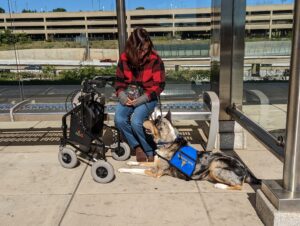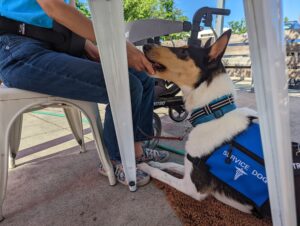Carefully selected and well-trained service dogs make public access work look easy and even boring. The majority of the time service dogs are in public, they are waiting quietly and patiently by their handler’s side. To the public, it looks like the dog is doing nothing. In reality, training a dog to be quiet and calm in a busy public setting with many distractions is very challenging. In fact, training a dog to “do nothing” can be a lot of work!
Service dogs typically need to learn to wait patiently in several different contexts. They need to briefly wait as their handler purchases items in stores or has a quick exchange with another person. In this case the dog needs to wait, while standing by the owner’s side in most cases, for a few moments before resuming other more active tasks. Service dogs also need to learn how to wait for much longer periods of time. For instance, they may need to wait by their handler at an airport for a flight, in a doctor’s office, or in a restaurant under a table. In these cases, the dog will typically wait in a down out of the way of foot traffic.
Waiting quietly in a busy environment, whether in a stand or down position, is not a behavior that comes naturally to most dogs. Even laid-back, lower-energy dogs can find waiting quietly difficult when there are many distractions. Service dog candidates that are more active may find this behavior more difficult to learn than actual tasks. Adding to the difficulty, service dogs need to be able to do wait quietly even when their handlers are not focused on the dogs’ behavior, because handlers need to be able to focus on things other than the dog as they go about their lives. In most cases, this behavior needs to be trained as a default behavior rather than one that is cued. That way when the handler stops moving the dog understands they should wait patiently.
Clearly, doing nothing is an important behavior for service dogs and one that is used frequently in all kinds of settings. Here are seven strategies that can help when teaching this skill.
Begin reinforcing quiet waiting starting from puppyhood.
Because this is a behavior that the dog needs to offer in a variety of contexts, it helps to build a long history of rewarding it right from the start. Owners and puppy raisers can do this by simply rewarding the pup for briefly waiting in various situations.
Adjust the reward to the dog’s behavior and the situation.
Using a lower-value reward may work better for young pups and mellow dogs because a high-value treat can prompt too much excitement. On the other hand, when working with an impatient adolescent dog or a more active dog, a higher-value treat may be needed. As with other skills, as the intensity of distractions increases, so should the value of the treat.
Give the dog time to adjust to a new setting first.
Make sure the dog is relaxed and comfortable in the environment before working on this behavior. A young service dog in training may need a few visits to a new, busy public access setting before they are ready to work on this behavior.
Time the delivery of the treat when the dog is calm.
Sometimes owners will respond by giving a treat when the dog shifts positions or stares up at them. It’s important for service dogs to learn to fully relax when waiting. Owners need to be taught how to look for indications that the dog is relaxed and waiting calmly, and be reminded to reward those behaviors.
Use a mat to help as a context cue.
Many trainers teach dogs to go to a mat. Teaching a long down on a mat can help serve as a context cue to dogs in training. When the long down on a mat is reliable in a low-distraction setting, trainers can take the mat to different locations to generalize the behavior.
Practice in front of a mirror.
Owners may be having a conversation with a friend or interacting with a business owner in a shop when they need the dog to wait. Practicing reinforcing a long, calm down while in front of a mirror or other reflective surface can help the handler reward the dog intermittently while not watching the dog.
Set up rehearsal opportunities
Just like with any other behavior, setting up rehearsal opportunities can help generalize the relaxed wait behavior. Trainers can set up a small table, chairs and snacks so service dog handlers can practice having their dogs wait quietly while they eat. As the dogs improve, distractions can be added, such as individuals trying to solicit the dogs’ attention or dropping food.
Some active service dog candidates may benefit from additional strategies to help them relax while they wait calmly. If the dog is very excitable, protocols that are used to teach dogs to relax such as Karen Overall’s Relaxation protocol and Suzanne Clothier’s Really Real Relaxation can be incorporated in the training process. Other dogs may benefit from an exercise session before training this long-duration behavior. Always consider the dog’s maturity and set the dog up to succeed. Owner-trainers may be surprised to discover that a one-year-old dog in the throes of adolescence can struggle with waiting patiently much more than a 12-week-old puppy who enjoys quick bursts of activity followed by lengthy naps. Trainers can help guide owners in adjusting criteria according to the dog’s abilities and maturity, and keep the process fun.


